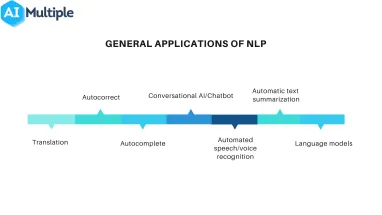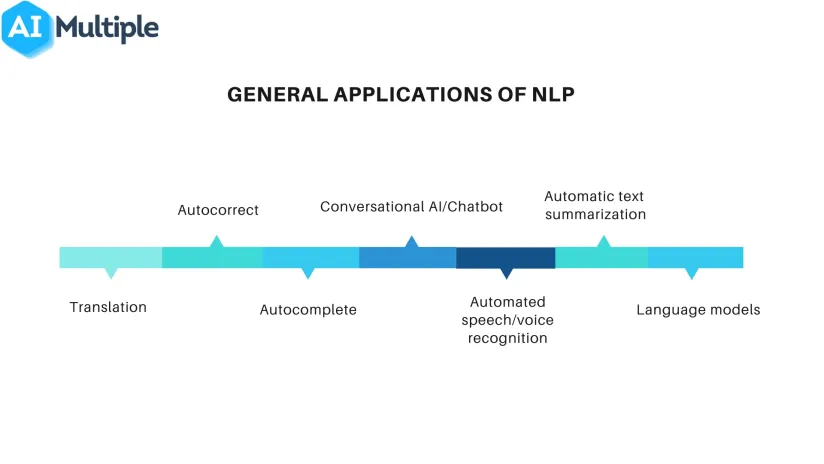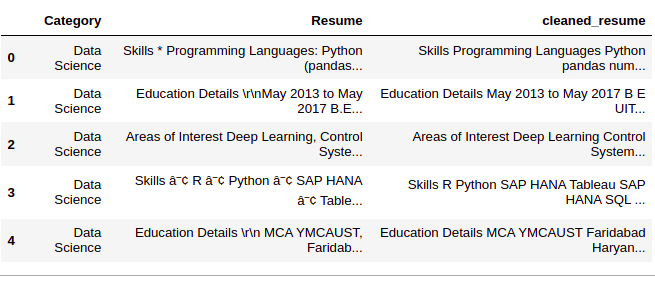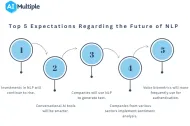Top 30 NLP Use Cases in 2024: Comprehensive Guide


Natural language processing (NLP) is a subfield of AI and linguistics that enables computers to understand, interpret and manipulate human language.
Although machines face challenges in understanding human language, the global NLP market was estimated at ~$5B in 2018 and is expected to reach ~$43B by 2025. And this exponential growth can mostly be attributed to the vast use cases of NLP in every industry.
You may be familiar with many day-to-day NLP applications such as autocorrection, translation, or chatbots. However, NLP has numerous impactful applications that business leaders are not aware of. Therefore, we compiled a comprehensive list of NLP use cases and applications and categorized them according to relevant industries and business functions:
General applications
1. Translation
One of the top use cases of natural language processing is translation. The first NLP-based translation machine was presented in the 1950s by Georgetown and IBM, which was able to automatically translate 60 Russian sentences into English. Today, translation applications leverage NLP and machine learning to understand and produce an accurate translation of global languages in both text and voice formats.
2. Autocorrect
NLP is used to identify a misspelled word by cross-matching it to a set of relevant words in the language dictionary used as a training set. The misspelled word is then fed to a machine learning algorithm that calculates the word’s deviation from the correct one in the training set. It then adds, removes, or replaces letters from the word, and matches it to a word candidate which fits the overall meaning of a sentence.
3. Autocomplete
Autocomplete, or sentence completion, combines NLP with certain machine learning algorithms (e.g. Supervised learning, Recurrent neural networks (RNN), or Latent semantic analysis (LSA)) to predict the likelihood of using a following word or sentence to complete the meaning.
4. Conversational AI
Conversational AI is the technology that enables automatic conversation between computers and humans. It is the heart of chatbots and virtual assistants like Siri or Alexa. Conversational AI applications rely on NLP and intent recognition to understand user queries, dig in their training data, and generate a relevant response.
Chatbots have numerous applications in different industries as they facilitate conversations with customers and automate various rule-based tasks, such as answering FAQs or making hotel reservations.
5. Automated speech/voice recognition
Voice recognition, also known as automatic speech recognition (ASR) and speech to text (STT), is a type of software that converts human speech from its analog form (acoustic sound waves) to a digital form that can be recognized by machines. ASR works by:
- Splitting the audio of a speech recording into individual sounds (tokens),
- Analyzing each sound,
- Using algorithms (NLP, deep learning, Hidden Markov Model, N-grams) to find the most probable word fit in that language,
- Converting the sounds into text.
Today, smartphones integrate speech recognition with their systems to conduct voice searches (e.g. Siri) or provide more accessibility around texting.
6. Automatic text summarization
Automatic text summarization is the process of shortening long texts or paragraphs and then generating a concise summary that passes the intended message. There are 2 main methods to summarize texts:
- Extractive summary: In this method, the output text will be a combination of meaningful sentences extracted directly from the original text.
- Abstractive summary: This method is more advanced, as the output is a new text. The aim is to understand the general meaning of sentences, interpret the context, and generate new sentences based on the overall meaning.
In both methods, NLP is used in the text interpretation steps, which are:
- Cleaning the text from filling words
- Sampling the text into shorter sentences (tokens)
- Creating a similarity matrix that represents relations between different tokens
- Calculating sentence ranks based on semantic similarity
- Selecting sentences with top ranks to generate the summary (either extractive or abstractive)

7. Language models
Language models are AI models which rely on NLP and deep learning to generate human-like text and speech as an output. Language models are used for machine translation, part-of-speech (PoS) tagging, optical character recognition (OCR), handwriting recognition, etc.
Some of the famous language models are GPT transformers which were developed by OpenAI, and LaMDA by Google. These models were trained on large datasets crawled from the internet and web sources to automate tasks that require language understanding and technical sophistication. For instance, GPT-3 has been shown to produce lines of code based on human instructions.
To find the right AI data partner for your NLP projects, check out the following articles:
- Top 12 AI Data Collection Services & Selection Criteria
- Data Crowdsourcing Platform: 10+ Companies & Criteria
Retail & e-commerce use cases
8. Customer service chatbot
Chatbots in customer service can:
- Answer FAQs.
- Schedule appointments.
- Book tickets.
- Process and track orders.
- Cross sell.
- Onboard new users.
To explore more use cases, feel free to read our in-depth article about chatbot use cases in customer service.
9. In-store bot
Several retail shops use NLP-based virtual assistants in their stores to guide customers in their shopping journey. A virtual assistant can be in the form of a mobile application which the customer uses to navigate the store or a touch screen in the store which can communicate with customers via voice or text. In-store bots act as shopping assistants, suggest products to customers, help customers locate the desired product, and provide information about upcoming sales or promotions.
To learn more about retail chatbots, click here.
10. Market intelligence
Marketers can rely on web scraping to extract e-commerce data (e.g. blogs, social media posts, news websites), as well as product data (reviews, ranks, comments) and combine it with NLP capabilities to analyze consumer sentiments, detect market trends, and optimize their marketing strategies.
11. Semantic based search
Semantic search refers to a search method that aims to not only find keywords but also understand the context of the search query and suggest fitting responses. Many online retail and e-commerce websites rely on NLP-powered semantic search engines to leverage long-tail search strings (e.g. women white pants size 38), understand the shopper’s intent, and improve the visibility of numerous products. Retailers claim that on average, e-commerce sites with a semantic search bar experience a mere 2% cart abandonment rate, compared to the 40% rate on sites with non-semantic search.
Read our article on the Top 10 eCommerce Technologies with Applications & Examples to find out more about the eCommerce technologies that can help your business to compete with industry giants.
Healthcare use cases
12. Dictation
To document clinical procedures and results, physicians dictate the processes to a voice recorder or a medical stenographer to be transcribed later to texts and input to the EMR and EHR systems. NLP can be used to analyze the voice records and convert them to text, to be fed to EMRs and patients’ records.
13. Clinical documentation
In 2017, it was estimated that primary care physicians spend ~6 hours on EHR data entry during a typical 11.4-hour workday. NLP can be used in combination with optical character recognition (OCR) to extract healthcare data from EHRs, physicians’ notes, or medical forms, to be fed to data entry software (e.g. RPA bots). This significantly reduces the time spent on data entry and increases the quality of data as no human errors occur in the process.
14. Clinical trial matching
NLP can be used to interpret the description of clinical trials and check unstructured doctors’ notes and pathology reports, to recognize individuals who would be eligible to participate in a given clinical trial. The algorithm used to develop such an NLP model would use medical records and research papers as training data to be able to recognize medical terminology and synonyms, interpret the general context of a trial, generate a list of criteria for trial eligibility, and evaluate participants’ applications accordingly.
A team at Columbia University developed an open-source tool called DQueST which can read trials on ClinicalTrials.gov and then generate plain-English questions such as “What is your BMI?” to assess users’ eligibility. An initial evaluation revealed that after 50 questions, the tool could filter out 60–80% of trials that the user was not eligible for, with an accuracy of a little more than 60%.
15. Computational phenotyping
Phenotyping is the process of analyzing a patient’s physical or biochemical characteristics (phenotype) by relying on only genetic data from DNA sequencing or genotyping. Computational phenotyping uses structured data (EHR, diagnoses, medication prescriptions) and unstructured data (physicians’ vocal records which summarize patients’ medical history, immunizations, allergies, radiology images, and laboratory test results, as well as progress notes and discharge reports). Computational phenotyping enables patient diagnosis categorization, novel phenotype discovery, clinical trial screening, pharmacogenomics, drug-drug interaction (DDI), etc.
In this case, NLP is used for keyword search in rule-based systems which search for specific keywords (e.g. pneumonia in the right lower lobe) through the unstructured data, filter the noise, check for abbreviations or synonyms, and match the keyword to underlying event defined previously by rules.
16. Computer assisted coding (CAC)
Computer Assisted Coding (CAC) tools are a type of software that screens medical documentation and produces medical codes for specific phrases and terminologies within the document. NLP-based CACs screen can analyze and interpret unstructured healthcare data to extract features (e.g. medical facts) that support the codes assigned.
17. Clinical diagnosis
NLP is used to build medical models that can recognize disease criteria based on standard clinical terminology and medical word usage. IBM Waston, a cognitive NLP solution, has been used in MD Anderson Cancer Center to analyze patients’ EHR documents and suggest treatment recommendations and had 90% accuracy. However, Watson faced a challenge when deciphering physicians’ handwriting, and generated incorrect responses due to shorthand misinterpretations. According to project leaders, Watson could not reliably distinguish the acronym for Acute Lymphoblastic Leukemia “ALL” from the physician’s shorthand for allergy “ALL”.
18. Virtual therapists
Virtual therapists (therapist chatbots) are an application of conversational AI in healthcare. NLP is used to train the algorithm on mental health diseases and evidence-based guidelines, to deliver cognitive behavioral therapy (CBT) for patients with depression, post-traumatic stress disorder (PTSD), and anxiety. In addition, virtual therapists can be used to converse with autistic patients to improve their social skills and job interview skills. For example, Woebot, which we listed among successful chatbots, provides CBT, mindfulness, and Dialectical Behavior Therapy (CBT).
Banking use cases
19. Stock price prediction
NLP is used in combination with KNN classification algorithms to assess real-time web-based financial news, to facilitate ‘news-based trading’, where analysts seek to isolate financial news that affects stock prices and market activity. To extract real-time web data, analysts can rely on:
To learn how web scraping is used in finance, read In-Depth Guide to Web Scraping for Finance.
20. Credit scoring
Credit scoring is a statistical analysis performed by lenders, banks, and financial institutions to determine the creditworthiness of an individual or a business.
NLP can assist in credit scoring by extracting relevant data from unstructured documents such as loan documentation, income, investments, expenses, etc. and feed it to credit scoring software to determine the credit score.
In addition, modern credit scoring software utilizes NLP to extract information from personal profiles (e.g. social media accounts, mobile applications) and utilize machine learning algorithms to weigh these features and assess creditworthiness.
Conversational banking can also help credit scoring where conversational AI tools analyze answers of customers to specific questions regarding their risk attitudes.
Sponsored:
Insurance use cases
21. Insurance claims management
NLP can be used in combination with OCR to analyze insurance claims. For example, IBM Watson has been used to comb through structured and unstructured text data to detect the right information to process insurance claims and feed it to an ML algorithm which labels the data according to the sections of the claim application form, and by the terminology that commonly is filled into it.
Finance department use cases
22. Financial reporting
NLP can be combined with machine learning algorithms to identify significant data in unstructured financial statements, invoices, or payment documentations, extract it, and feed it to an automation solution, such as an RPA bot utilized for reporting to generate financial reports.
23. Financial auditing
NLP enables the automation of financial auditing by:
- Screening financial documents of an organization
- Classifying financial statement content
- And identifying document similarities and differences
In turn, this enables the detection of deviations and anomalies in financial statements.
24. Fraud detection
NLP can be combined with ML and predictive analytics to detect fraud and misinterpreted information from unstructured financial documents. For instance, a study revealed that NLP linguistic models were able to detect deceptive emails, which were identified by a “reduced frequency of first-person pronouns and exclusive words, and elevated frequency of negative emotion words and action verbs”. The researchers used an SVM classifier algorithm to analyze linguistic features of annual reports, including voice, active versus passive tone, and readability, detecting an association between these features and fraudulent financial statements.
HR use cases
25. Resume evaluation
NLP can be used in combination with classification machine learning algorithms to screen candidates’ resumes, extract relevant keywords (education, skills, previous roles), and classify candidates based on their profile match to a certain position in an organization. Additionally, NLP can be used to summarize resumes of candidates who match specific roles to help recruiters skim through resumes faster and focus on specific requirements of the job.

26. Recruiting chatbot
Recruiting chatbots, also known as hiring assistants, are used to automate the communication between recruiters and candidates. Recruiting chatbots use NLP for:
- Screening candidate resumes,
- Scheduling interviews,
- Answer candidates’ questions about the position,
- Build candidate profiles,
- Facilitating candidate onboarding.
27. Interview assessment
Many large enterprises, especially during the COVID-19 pandemic, are using interviewing platforms to conduct interviews with candidates. These platforms enable candidates to record videos, answer questions about the job, and upload files such as certificates or reference letters. NLP is particularly useful for interview platforms to analyze candidate sentiment, screen uploaded documentations, check for references, detect specific keywords which can reflect positive or negative behavior during the interview, as well as transcribe the video and summarize it for archiving purposes.
28. Employee sentiment analysis
NLP can be used to detect employees’ job satisfaction, motivation, friction areas, difficulties, as well as racial and sexual bias. NLP is used to screen feedback surveys, public emails, employee comments on social media and job employment websites, etc. This enables HR employees to better detect conflict areas, identify potential successful employees, recognize training requirements, keep employees engages, and optimize the work culture.
Feel free to read our article on HR technology trends to learn more about other technologies that shape the future of HR management.
Cybersecurity use cases
29. Spam detection
NLP models can be used for text classification in order to detect spam-related words, sentences, and sentiment in emails, text messages, and social media messaging applications. Spam detection NLP models typically follow these steps:
- Data cleaning and preprocessing: removing filling and stop words.
- Tokenization: sampling text into smaller sentences and paragraphs.
- Part-of-speech (PoS) tagging: tagging a word in a sentence or paragraph to its corresponding part of a speech tag, based on its context and definition.
The processed data will be fed to a classification algorithm (e.g. decision tree, KNN, random forest) to classify the data into spam or ham (i.e. non-spam email).

30. Data exfiltration prevention
Data exfiltration is a security breach that involves unauthorized data copying or transfer from one device to another. To exfiltrate data, attackers use cybersecurity techniques such as domain name system (DNS) tunneling (i.e. DNS queries which reflect a demand for information sent from a user’s computer (DNS client) to a DNS server) and phishing emails which lead users to provide hackers with personal information. NLP can be used to detect DNS queries, malicious language, and text anomalies to detect malware and prevent data exfiltration.
For more on NLP
To explore what natural language processing is, and what are its products, feel free to read our in-depth articles:
- Top 5 Expectations Regarding the Future of NLP
- In-Depth Guide to NLP: What it is, How it Works & Top Use Cases
- Natural Language Understanding: in-Depth Guide
- NLU vs NLP: Main Differences & Use Cases Comparison
- Natural Language Generation (NLG): What it is & How it works
If you believe your business will benefit from a conversational AI solution, scroll down our data-driven lists of:
And we can guide you through the process:
This article was drafted by former AIMultiple industry analyst Alamira Jouman Hajjar.

Cem has been the principal analyst at AIMultiple since 2017. AIMultiple informs hundreds of thousands of businesses (as per similarWeb) including 60% of Fortune 500 every month.
Cem's work has been cited by leading global publications including Business Insider, Forbes, Washington Post, global firms like Deloitte, HPE, NGOs like World Economic Forum and supranational organizations like European Commission. You can see more reputable companies and media that referenced AIMultiple.
Throughout his career, Cem served as a tech consultant, tech buyer and tech entrepreneur. He advised businesses on their enterprise software, automation, cloud, AI / ML and other technology related decisions at McKinsey & Company and Altman Solon for more than a decade. He also published a McKinsey report on digitalization.
He led technology strategy and procurement of a telco while reporting to the CEO. He has also led commercial growth of deep tech company Hypatos that reached a 7 digit annual recurring revenue and a 9 digit valuation from 0 within 2 years. Cem's work in Hypatos was covered by leading technology publications like TechCrunch and Business Insider.
Cem regularly speaks at international technology conferences. He graduated from Bogazici University as a computer engineer and holds an MBA from Columbia Business School.
To stay up-to-date on B2B tech & accelerate your enterprise:
Follow on

Comments
Your email address will not be published. All fields are required.